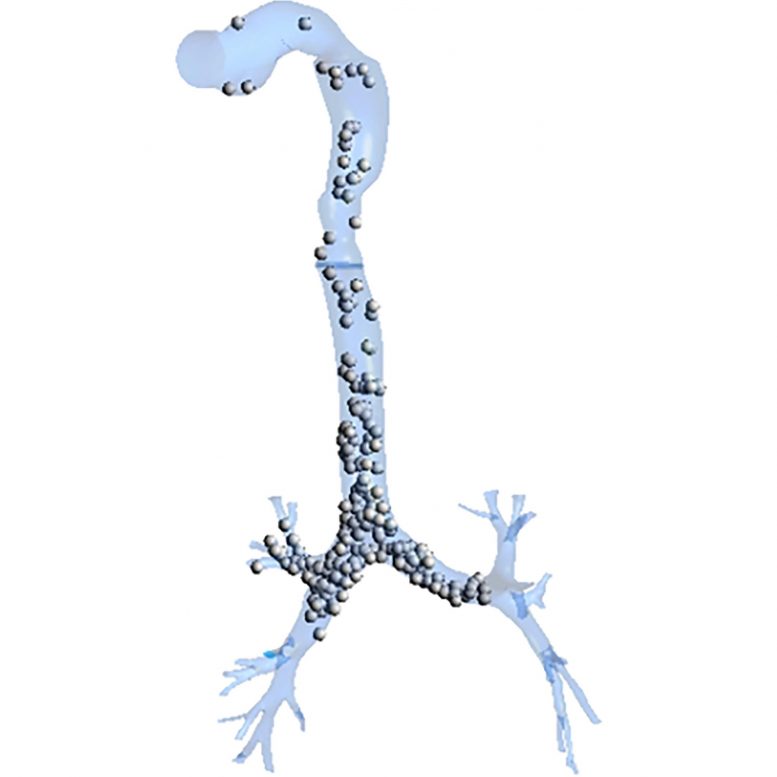
The computational evaluation shows a spatial distribution of single micron-sized drug particles in human respiratory tract at three seconds. Credit: Akshoy R. Paul
Size of drug particles plays key role in effectiveness of medicine.
Increased air pollution in recent years has not only contributed to deteriorating environmental conditions in cities across the globe. It has also exacerbated health risks for the people who populate them, particularly those who suffer from pulmonary diseases, such as asthma or chronic obstructive pulmonary disease (COPD). These dynamics underscore the importance of work to increase the efficacy of drug delivery devices, such as inhalers, that administer active pharmaceutical ingredients to treat respiratory illnesses.
In Physics of Fluids, by AIP Publishing, researchers from India and Australia describe the results of their collaboration in developing a computational evaluation of drug delivery through both pressurized metered-dose inhalers and dry powder inhalers to determine how the process can be improved.
While inhalers have revolutionized the treatment of pulmonary diseases in the last few decades and are currently being used to administer drugs to patients infected by the COVID-19 virus, “their efficacy remains a great concern as only one-third of the total drug reaches the affected regions of the lungs,” said co-author Suvash C. Saha, from the University of Technology Sydney. “As a result, the drug loss and cost of the treatment become higher.”
Traveling of single micron-sized drug particles from mouth through respiratory tract are computed at different moments following inhalation. Credit: Akshoy R. Paul
Knowing an ability to predict aerosolized or powdered drug deposition in the lungs is vital to better understand targeted drug delivery, Saha and colleagues at the Motilal Nehru National Institute of Technology Allahabad, in India, created a computational model to evaluate where improvements can be made.
“At higher flow rates, inertial impaction is found to be responsible for deposition of drug particles in the upper portion of the airways but with lesser availability of drug particles in the distal region of the airways,” said co-author Akshoy Ranjan Paul. “Additionally, at lower flow rates, there is not enough momentum to carry particles to the distal region. As a result, there should be an optimum flow rate [to achieve] maximum reach of drug particles in the distal region.”
The researchers present a computational investigation of inhalation rates and drug particle sizes in a realistic human lung model. Using computation fluid dynamics, the study reveals that more drug particles are deposited in the right bronchi than in the left bronchi, which is relatively curved due its proximity to the heart. Key findings suggest the drugs should contain smaller-sized particles to enable their reach in the distal bronchi.
The research “is a notable example that demonstrates how the understanding of fluid mechanics, and the power of computational fluid dynamics, can inform more effective design of drugs and drug-administering devices,” said Saha.
Reference: “Computational evaluation of drug delivery in human respiratory tract under realistic inhalation” by Anurag Tiwari, Anuj Jain, Akshoy R. Paul and Suvash C. Saha, 10 August 2021, Physics of Fluids.
DOI: 10.1063/5.0053980








Be the first to comment on "Room for Improvement in Inhalers Revealed by Computational Evaluation of Drug Delivery"